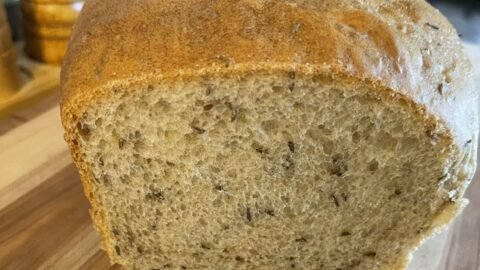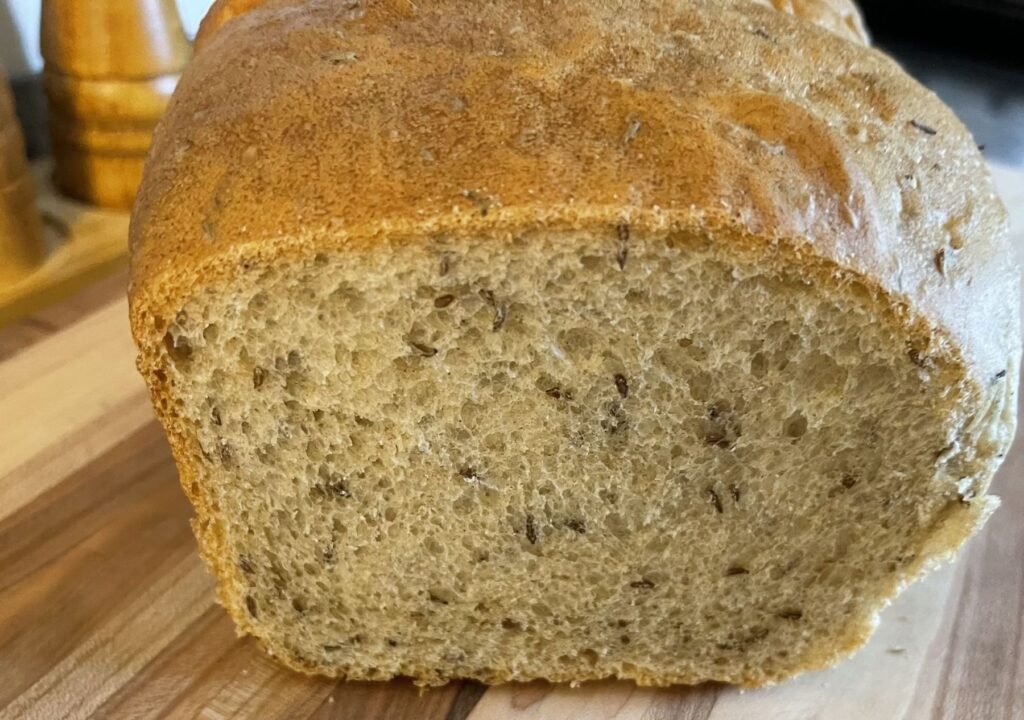
There’s something special about a warm, homemade loaf of rye bread. It has a rustic charm that instantly makes any meal feel a bit cozier. But what if I told you there’s a way to make it even better? The secret lies in an ingredient most people wouldn’t expect—pickle juice! Yes, you read that right. Adding a splash of pickle juice to the dough not only enhances the bread’s tangy flavor but also gives it a unique twist that will have everyone guessing what the “secret” ingredient is. And with the addition of water and vegetable oil for moisture, this loaf is as tender as it is flavorful. Let’s dive into this unexpected take on a classic loaf.
What Makes Rye Bread Special?
Rye Flour vs. Wheat Flour
The rye flour and wheat flour might look similar, but they behave very differently in baking. Rye is lower in gluten, which means it doesn’t create as much stretch in the dough. That’s why rye bread is denser and chewier compared to a fluffy wheat loaf. It also has a higher moisture content, so your dough might feel stickier—but don’t worry, that’s normal!
Another key difference is the flavor. Rye has a deeper, slightly tangy taste that pairs well with both sweet and savory ingredients. Adding pickle juice amplifies that tang, giving the bread a bright, zesty finish without overpowering the natural sweetness of the rye flour.
The Surprising Role of Pickle Juice
You might wonder, “Why pickle juice?” It’s not just about adding a touch of acidity. Pickle juice is packed with salt and spices, which can add a new layer of complexity to your bread. Using it in place of some (or all) of the water helps develop a more balanced taste. It’s like an instant flavor enhancer—no need for extra seasonings or additives.
**Tip:** Use the juice from dill pickles rather than sweet pickles, as the sweet varieties can throw off the balance of flavors.
Ingredients Breakdown
To get the best loaf of rye bread, choosing the right ingredients is crucial. Here’s what you’ll need:
-
Rye Flour: You can use light, medium, or dark rye flour depending on your preference. Light rye gives a milder flavor, while dark rye has a richer taste and a denser texture.
-
Bread Flour: Because rye flour is low in gluten, adding bread flour helps give the dough a bit more structure and elasticity.
-
Rapid Dry Yeast: This helps the dough rise and gives the bread a good texture.
-
Vegetable Oil: This helps create a tender, moist crumb that lasts.
-
Dill Pickle Juice: The star of the show! It gives the bread a subtle tang.
-
Dark Brown Sugar: A touch of sweetness helps balance the acidity from the pickle juice.
-
Salt: Necessary for flavor and also for controlling the rise.
-
Water: Adjust the amount based on how much pickle juice you use.
-
Optional: Caraway Seeds
: For a more traditional flavor, add caraway seeds. They lend a distinctive aroma that pairs beautifully with rye.
Step-by-Step Recipe Guide
1. Preparing the Dough: In a large mixing bowl, combine your rye flour, all-purpose flour, salt, and yeast. Mix in the pickle juice, vegetable oil, brown sugar and warm water, and caraway seeds (if adding) stirring until the ingredients start to come together. Cover and let rest for 20 minutes. The dough will be sticky—don’t worry, that’s normal for rye. Just keep working with it until everything is well combined. If you’re new to working with rye, don’t be alarmed by the stickiness. Rye dough behaves differently from wheat dough, so resist the urge to keep adding flour. The dough will smooth out during the kneading process.
2. Kneading and First Rise Turn the dough out onto a lightly floured surface and knead it for about 8-10 minutes. It won’t become as smooth as a wheat dough, but it should become more elastic and easier to handle. Place the dough in an oiled bowl (the vegetable oil you added earlier will help the dough stay moist), cover it with a damp cloth, and let it rise in a warm place for about 1 to 1.5 hours, or until it has doubled in size.
3. Shaping the Loaf Once the dough has risen, gently deflate it and turn it out onto a floured surface. Shape it into a round boule or an oblong loaf, depending on your preference.
4. Second RisePlace the shaped loaf onto a baking sheet or into a loaf pan, cover it again, and let it rise for another 30-45 minutes. This second rise is where the flavor really develops, so don’t rush it.
5. Baking Your Rye Bread Preheat your oven to 400°F (200°C). Bake the bread for 25-30 minutes, or until the crust is a deep golden brown and sounds hollow when tapped on the bottom. For an extra crispy crust, place a shallow pan of water in the oven while baking to create steam.
Easy to Make, Hard to Forget
This rye bread recipe is straightforward, even if you’re new to working with rye flour. The addition of pickle juice takes it from good to unforgettable, giving a unique flavor profile that lingers long after your last bite. I love that it makes the bread feel just a little bit fancy without adding complexity to the process.
Serving Suggestions
- Classic Pairings: This bread is perfect for hearty sandwiches. Try it with pastrami, Swiss cheese, and sauerkraut for a homemade Reuben, or serve it alongside a creamy bowl of soup.
- Breakfast Toast: Toast a slice and top it with avocado, a sprinkle of sea salt, and thinly sliced radishes for a simple but satisfying breakfast.
- Grilled Cheese with a Twist: Use this rye bread to make a gooey grilled cheese.
This rye bread recipe is not just about baking a loaf of bread—it’s about taking a classic and adding your own twist. The pickle juice might raise a few eyebrows, but once you try it, you’ll see why it’s become my go-to ingredient for adding a little extra something. So go ahead, give it a try, and let me know how it turns out!
I’d love to hear your thoughts! Share your own experiences or let me know if you added your own twist to the recipe in the comments below. If you post your loaf on social media, be sure to tag me so I can see your delicious creations! Happy bread baking!
Additional Bread Recipes To Try:
Easy
Homemade Sandwich Bread Recipe
Sensational Sourdough Raisin Bread Creation
Ultimate Fluffy Hotdog Buns from Scratch
Easy Rye Bread From Scratch
This hearty homemade rye bread is a rustic loaf packed with flavor. The subtle earthy notes of rye flour balance perfectly with a hint of sweetness, giving each slice a dense yet tender texture. Whether toasted with butter or used to make your favorite sandwich, this bread brings a delightful, old-world charm to your table. Simple ingredients, a bit of patience, and a lot of reward—it's the perfect addition to any meal.

Ingredients
Instructions
-
In a large bowl, mix rye flour, all-purpose flour, salt, yeast, pickle juice, vegetable oil, brown sugar, warm water, and caraway seeds until combined. Cover and let rest for 20 minutes. The dough will be slightly sticky—this is normal for rye.
-
Turn the dough onto a floured surface and knead for 8-10 minutes until elastic. Place in an oiled bowl, cover with a damp cloth, and let rise in a warm place for 1 to 1.5 hours or until doubled in size.
-
Gently deflate the dough and shape it into a boule or oblong loaf.
-
Place the shaped loaf on a baking sheet or in a loaf pan, cover, and let rise for 30-45 minutes.
-
Preheat the oven to 400°F (200°C). Bake for 25-30 minutes until the crust is golden brown and sounds hollow when tapped. For a crispy crust, add a pan of water in the oven while baking.

